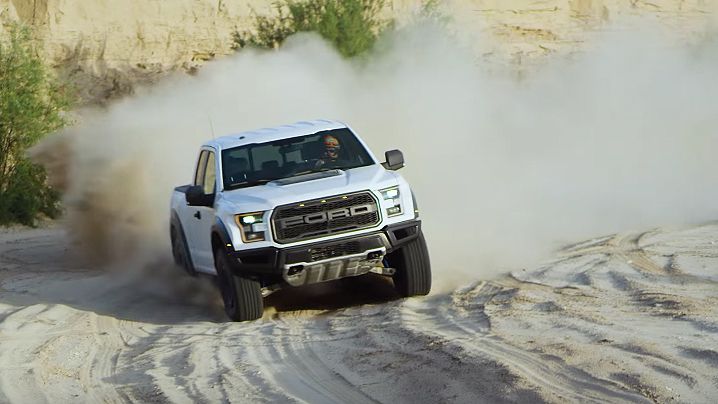Ford has released the third video in its six-part series detailing the all-new 2017 F-150 Raptor. (Check out part one here and part two here.) This short video details the Raptor’s new Terrain Mode system and its six settings designed to handle every surface possible.
The electronics control vehicle systems like throttle response, transmission shift points, ABS braking action, and traction control functions. These metrics allow the driver to customize the Raptor to any type of terrain.
The system’s six settings include Normal, Sport, Weather, Mud/Sand, Baja, and Rock Crawl. In normal mode, well… things are normal. This is the setting for cruising around town on a typical Tuesday. Sport mode, however, is designed for a fun Friday night. “Mountain passes are no longer just for Mustang,” Ford’s press materials say. Weather mode is for when road conditions deteriorate due to rain or snow. This mode engages 4WD Auto on the transfer case and decreases throttle sharpness and smoothes transmission shifting to keep traction between the tires and pavement.
Three off-road setting let the Raptor really shine. Mud/Sand Mode is pretty self-explanatory. 4WD high range is automatically selected and the rear differential is automatically locked. The AdvanceTrac traction control system allows for much greater slippage while keeping the 3.5-liter V-6 at full power. The steering is also kept in comfort mode, which is said to make navigating tight trails and over obstacles easier.
Baja Mode is for those iconic shots of blasting over sand dunes and romping a outrageous speeds across the desert. The transfer case is set to 4WD high range and the traction control is dialed back to its least intrusive setting. The throttle is sharpened for more immediate power and the transmission shifts are quickened and it holds gears longer.
Lastly, Rock Crawl Mode is yet another self-explanatory setting. Here, the truck is prepped for hard-core, slow-n-steady climbing of boulders and rocks. 4WD low range is selected, the electronically locking rear diff is engaged, and the traction control is restricted for a more direct experience. What’s more, the front camera shows what’s ahead of the truck and remains on up to 15 mph.
Of course, traction control and the traction management system can be turned completely off, allowing the driver to assume full control over the truck. A word to the wise, though – leave that to the professionals.
Continue reading for more information
Why It Matters
Ford’s six-part mini-series on the 2017 Raptor helps highlight the trick’s features and purpose. Items like tire choice and its race-proven long-travel suspension system to its outward design is covered in the series. While informative, it’s basically Ford brewing interest in the truck before its late 2016 release.
The 2017 Raptor builds on the major success of the first-generation Raptor. However, Ford engineers have parted ways with the classic V-8 powerplant. Instead, the next-generation of Ford’s popular 3.5-liter EcoBoost V-6 will power the truck. The twin-turbocharged V-6 isn’t some fuel economy penalty box. Nope, Ford says the EcoBoost will deliver more horsepower and torque than the old 6.2-liter V-8. That means we can expect more than 411 horsepower and 434 pound-feet of torque.
Backing the V-6 is a new 10-speed automatic transmission co-developed with General Motors. It’s the same 10-speed that’s slotted for the track-ready Chevrolet Camaro ZL1 and upcoming Ford Mustang. Behind the transmission is an electronically operated, two-speed transfer case that delivers power to the front wheels when 4WD is engaged.
The 2017 Raptor should arrive in dealerships in the fall of 2016. Prices have not been announced, but we expect the base MSRP to start around $50,000.
2017 Ford F-150 Raptor
Read our full review on the 2017 Ford F-150 Raptor here.

